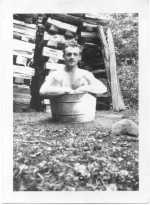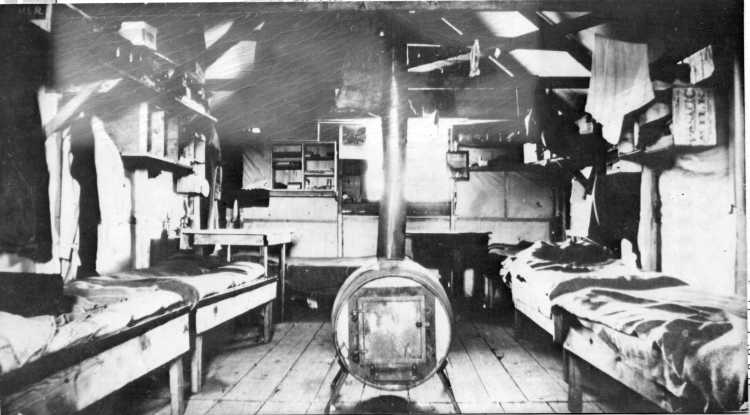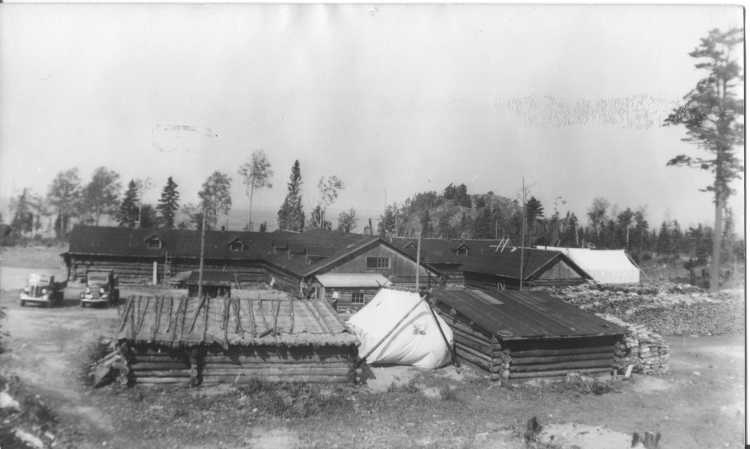Page
1 | Page 2 | Page 3 | Page
4 | Page 5 | Page
6 | Back to Life at Camp Page
Jake
Krueger remembers the lack of privacy in his camp.
 “Oh,
the realities of life we had to contend with. Our laundry shack
also doubled as a communal bath house, with a do-it-yourself water
heater. A tub of water sitting on the barrel heater fed by wood
slabs gave us our hot water, dipped from a barrel standing by
the door, filled daily by the bull-cooks. Our bath tubs were regular
steel wash tubs about 30 inches [75 cm] in diameter and 14 to
16 inches [35 to 40 cm] high. With no locks on the door, privacy
was at a minimum as we bathed ourselves in the evening.” [ASM,
236] “Oh,
the realities of life we had to contend with. Our laundry shack
also doubled as a communal bath house, with a do-it-yourself water
heater. A tub of water sitting on the barrel heater fed by wood
slabs gave us our hot water, dipped from a barrel standing by
the door, filled daily by the bull-cooks. Our bath tubs were regular
steel wash tubs about 30 inches [75 cm] in diameter and 14 to
16 inches [35 to 40 cm] high. With no locks on the door, privacy
was at a minimum as we bathed ourselves in the evening.” [ASM,
236]
He
also gives a good description of his bunk house in BC.
“Our
bunkhouses were all built to one pattern. A two by four frame
clad with rough boards (not interlocking) on the outside, with
a coat of black tar paper held in place by narrow slats, [and]
that is it. [There was] no cladding on inside walls, no insulation,
no ceilings, and definitely no paint anywhere.
“Kiln
dried lumber was unheard of then, so the wet cladding
dried apart, creating cracks in the tar paper. Fortunately, because
of the dense forest all around, very little wind every touched
our camp, or we might have woken one morning in wintertime with
a small snow drift across our [sleeping] bags!"
“The
open spaces between the two by fours were utilized by everybody
for open shelves over our beds to store personal effects, as pilfering
was not a problem. The floors were built of two by sixes which
also dried apart permitting sickly looking grass to peek through
in summertime. On the prairies these buildings would not have
been good enough for cattle, but in B.C. with its milder temperature
and practically no wind, they sufficed. Though our bull-cooks
stoked the fires in our heaters before lights out and again during
the night."
“But
with no air circulation, other than our breath, those guys who
slept close to the heaters roasted, while in the far corner they
could not get enough blankets! In both camps I was lucky to latch
onto a cot close to the heat, so to ward off the intense heat
at times, Andy and I built a free standing partition, three feet
high, of boards and had it standing at the foot of our cots."
“All
bunkhouses stood off the ground about six inches [15 cm] on blocks,
so as to keep the winter chill and wandering small animals at
bay, they were ringed with tightly compacted hay bales, with a
low wooden border keeping them snug against the wall. Each abode
had about 10 windows and one door, which had no lock.” [ASM,
249-250]
 |
 |
| Inside of a bunkhouse |
Montreal River camp photo |
View
some hand-drawn maps of actual camp buildings.
Map
1 | Map 2 | Map
3
Abram
J. Thiessen served both in Manitoba and in BC. As Jake Krueger mentioned,
making sure the cabins were well heated was important in the cold
prairie winter.
“Our
living quarter was a large H shaped bunkhouse. If I remember correctly
we were seventy-five in one building which was heated by a number
of wood burning heaters seemingly made by converting fuel drums.
The bunk beds were all upper and lower so for perhaps some imagined
reason I chose an upper bunk. A man with the title of bullcook
was on duty all night to tend to heating and guard against fires.
[ASM, 30-49]
Later,
Thiessen moved to Camp Hill 60 in BC.
“What
we first saw was a large water tank mounted on a scaffold tower
approximately twenty feet [6 m] high in one corner of the camp.
Next to the water tower was a large building which served a laundry,
shower stalls, and sinks for personal washing. Next was a general
purpose storage shed next to a food storage shed and next to that
a large kitchen and dining room. Across an open area to the north
were 14 of what I will generously call cabins which measured about
12 feet [3.6 m] by 14 or 16 feet [4.2 or 4.8 m] long. These cabins
we occupied each had three cots for sleeping in and sitting on
as no chairs were included mainly because there was no room for
them. The cabins were of clapboard construction with tar paper
siding and roof. About a foot [30 cm] above the roof a white canvas
sheet was positioned and this had a cooling effect on the cabin.”
[ASM, 33-47]
Page
1 | Page 2 | Page 3 | Page
4 | Page 5 | Page
6 | Back to Life at Camp Page |


